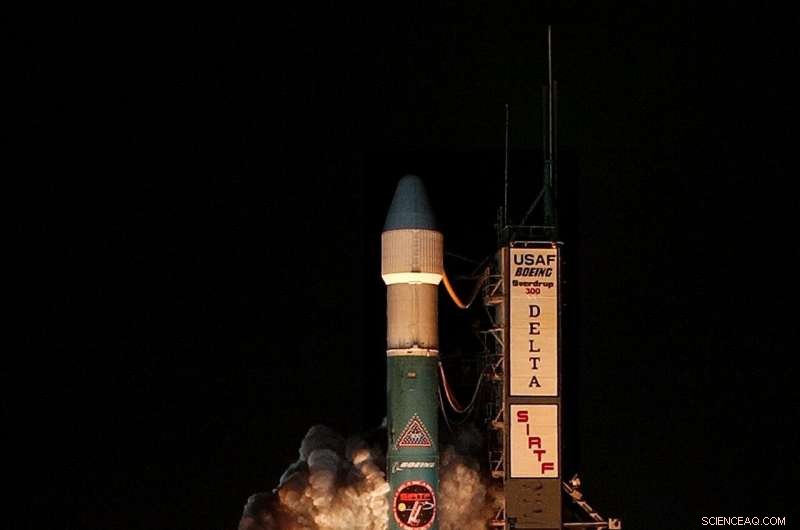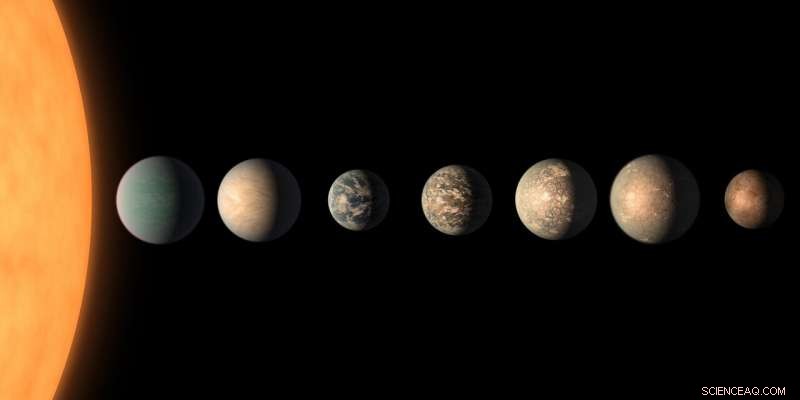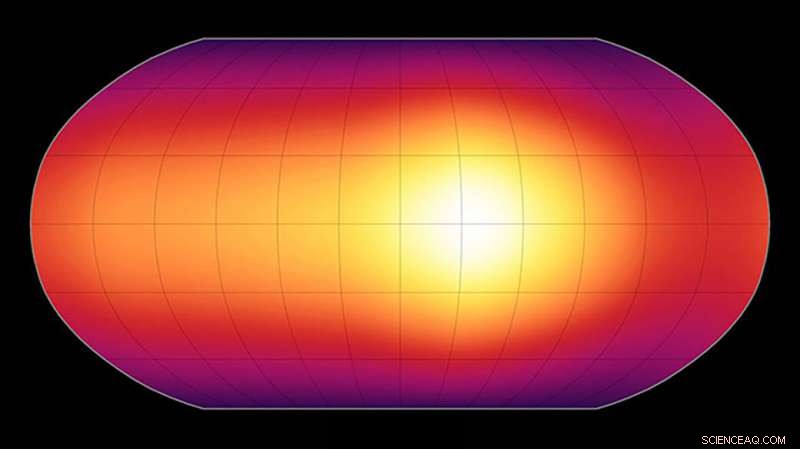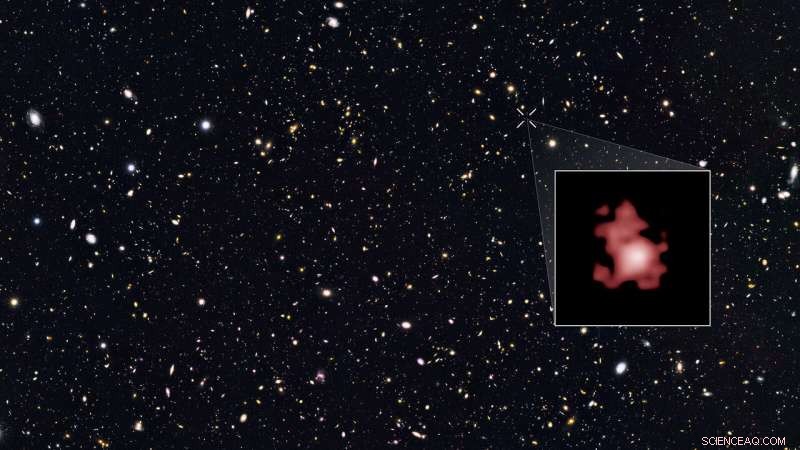
Il telescopio spaziale Spitzer della NASA, allora noto come Space Infrared Telescope Facility, lanci dalla stazione aeronautica di Cape Canaveral in Florida lunedì, 25 agosto 2003. Credito:NASA
Quando una finestra sull'universo si chiude, un altro si aprirà con una vista ancora migliore. Alcuni degli stessi pianeti, le stelle e le galassie che abbiamo visto per la prima volta attraverso la prima finestra appariranno con dettagli ancora più nitidi in quella che si aprirà presto.
Il telescopio spaziale Spitzer della NASA conclude la sua missione il 30 gennaio, 2020, dopo più di 16 straordinari anni di esplorazione. Il telescopio ha fatto molte scoperte oltre l'immaginazione dei suoi progettisti, come i pianeti al di fuori del nostro sistema solare, chiamati esopianeti, e galassie che si sono formate vicino all'inizio dell'universo. Molte delle scoperte di Spitzer saranno studiate in modo più preciso con il prossimo James Webb Space Telescope, che dovrebbe essere lanciato nel 2021.
"Abbiamo molte nuove domande da porre sull'universo a causa di Spitzer, " ha detto Michael Werner, Scienziato del progetto Spitzer con sede presso il Jet Propulsion Laboratory della NASA a Pasadena, California. "È molto gratificante sapere che c'è una serie così potente di capacità in arrivo per dare seguito a ciò che siamo stati in grado di iniziare con Spitzer."
Sia Webb che Spitzer sono specializzati per la luce infrarossa, che è invisibile agli occhi umani. Ma con il suo gigantesco specchio al berillio rivestito d'oro e nove nuove tecnologie, Webb è circa 1, 000 volte più potente. Il prossimo telescopio sarà in grado di spingere le scoperte scientifiche di Spitzer verso nuove frontiere, dall'identificazione di sostanze chimiche nelle atmosfere degli esopianeti alla localizzazione di alcune delle prime galassie formatesi dopo il Big Bang.
Al di là delle sue scoperte, Spitzer è anche un pioniere per Webb in termini di come far funzionare un telescopio di questo tipo. Per misurare la luce infrarossa con un'elevata sensibilità, un telescopio deve essere molto freddo. Spitzer ha mostrato agli ingegneri come si comporta un osservatorio a infrarossi nella vastità dello spazio e con quali temperature i pianificatori di missioni dovrebbero aspettarsi di fare i conti con Webb.
"Avere un enorme telescopio nello spazio è difficile. Ma avere un enorme telescopio freddo è molto più difficile, " ha detto Amber Straughn, vice scienziato del progetto per le comunicazioni scientifiche del telescopio spaziale James Webb. "Spitzer ci ha aiutato a imparare a far funzionare meglio un telescopio molto freddo nello spazio".
Con più di 8, 700 articoli scientifici pubblicati sulla base delle scoperte di Spitzer, il telescopio è stato una risorsa straordinaria per gli astronomi in una varietà di discipline. Molti di questi allettanti risultati sono maturi per essere rivisitati con un telescopio più potente, e Webb è pronto a iniziare a esaminarli all'inizio della sua missione. Ecco un esempio dei successi di Spitzer su cui Webb si baserà.

Il concept di questo artista mostra come potrebbe essere il sistema planetario TRAPPIST-1, sulla base dei dati disponibili sui diametri dei pianeti, masse e distanze dalla stella ospite. Il telescopio spaziale Spitzer ha confermato la presenza di due pianeti delle dimensioni della Terra nel sistema prima di scoprirne altri cinque. Credito:NASA/JPL-Caltech
Esopianeti
Una delle scoperte più sorprendenti di Spitzer è stata che non ce ne sono solo tre, ma sette pianeti rocciosi delle dimensioni della Terra orbitanti attorno a un piccolo, debole stella chiamata TRAPPIST-1. TRAPPIST-1 è uno dei sistemi planetari più studiati a parte il nostro, ma c'è molto altro da imparare a riguardo.
Il quarto pianeta dalla stella, TRAPPIST-1e è particolarmente interessante perché ha una densità e una gravità superficiale molto simili a quelle della Terra e riceve abbastanza radiazioni stellari da avere temperature sufficientemente favorevoli all'acqua liquida. Webb osserverà questo pianeta per avere un'idea migliore se il pianeta ha un'atmosfera e, se è così, qual è la sua chimica.
La presenza di molecole come l'anidride carbonica, dominante su Marte e Venere, avrebbe implicazioni sul fatto che un pianeta possa avere acqua liquida e altre condizioni abitabili. Webb sarà in grado di rilevare l'acqua atmosferica, pure. Inoltre, Webb cercherà il calore proveniente da TRAPPIST-1b, il pianeta più vicino alla sua stella.
"La diversità delle atmosfere intorno ai mondi terrestri è probabilmente oltre la nostra più sfrenata immaginazione, " ha detto Nikole Lewis, assistente professore di astronomia alla Cornell University di Ithaca, New York. "Ottenere qualsiasi informazione sull'aria su questi pianeti sarà molto utile".
WASP-18b è un altro pianeta intrigante che Spitzer ha esaminato e che Webb indagherà ulteriormente nelle osservazioni all'inizio della missione. Questo gigante gassoso, con 10 volte la massa di Giove, si trova vicinissimo alla sua stella, completando un'orbita una volta ogni 23 ore. A causa della sua alta temperatura, un enorme 4, 800 gradi Fahrenheit (2, 650 gradi Celsius) e di grandi dimensioni, è conosciuto come un "Giove caldo". Utilizzando i dati di Spitzer e Hubble, astronomers figured out in 2017 that this planet has a lot of carbon monoxide in its upper atmosphere and little water vapor. This planet is particularly interesting because it's so close to its star that it's in danger of being torn apart completely, and it may not survive another million years. Astronomers are interested in using Webb to look at the processes happening in this planet's atmosphere, which will provide insights into hot Jupiters in general.
Spitzer has also delivered unprecedented weather reports for exoplanets. Nel 2007, it made the first-ever map of the surface of an exoplanet, the hot Jupiter HD 189733b, showing its temperature variations and cloud tops. Più recentemente, nel 2016, Spitzer highlighted the climate patterns of 55 Cancri e, a possibly lava-covered world more than twice the size of Earth. But maps from Spitzer have given scientists a lot to think about as they look to further investigations with Webb.

This is the first-ever map of the surface of an exoplanet, or a planet beyond our solar system. The map, which shows temperature variations across the cloudy tops of a gas giant called HD 189733b, is made from infrared data taken by NASA's Spitzer Space Telescope. Credit:NASA/JPL-Caltech/Harvard-Smithsonian CfA
Other Exotic Objects
Spitzer has also made strides in identifying and characterizing brown dwarfs. A brown dwarf is larger than a planet but less massive than a star, and while stars generate their own energy by fusing hydrogen, brown dwarfs do not. Spitzer has been able to look at the clouds in brown dwarf atmospheres and observe how they move and change shape with time. Webb will also examine brown dwarf cloud properties and delve deeper into the physics of these mysterious objects.
Infrared light has also been revolutionary for looking at disks of gas and dust orbiting stars, and both Spitzer and Webb are sensitive to the infrared glow of this material. Disks that Spitzer has studied contain the raw materials for making planets and may represent the state of our solar system before Earth and its neighbors formed. Spitzer has seen particles around young stars beginning to transform into the seeds of small planetary bodies, and that some disks have materials similar to those seen in comets in our solar system. Webb can look at the same disks and find out even more about the planetary formation process.
Oodles of Galaxies
As light travels from distant objects to Earth, its wavelength becomes longer because the universe is expanding and those objects are moving farther from us. Just like the sound of a siren seems to lower in pitch as an ambulance drives away, light from distant galaxies also lowers in frequency, a phenomenon called "redshift." That means stars that give off visible light in the early universe will appear in the infrared by the time their light reaches Earth. This makes infrared light an especially powerful tool for exploring the universe's ancient past.
Pinpointing hundreds of billions of galaxies is currently impossible, but Spitzer has made large galaxy catalogs that represent different slices of the universe, containing some of the most distant galaxies we know. The large survey areas of Spitzer and Hubble Space Telescope have allowed astronomers to efficiently look for objects that could be studied in further detail with Webb.
Per esempio, Spitzer, together with Hubble, took an image of a galaxy called GN-z11, which holds the record for most distant galaxy measured yet. It is a relic from when the universe was only 400 million years old, just 3% of its current age and less than 10% of its size today.

This is the first-ever map of the surface of an exoplanet, or a planet beyond our solar system. The map, which shows temperature variations across the cloudy tops of a gas giant called HD 189733b, is made from infrared data taken by NASA's Spitzer Space Telescope. Credit:NASA/JPL-Caltech/Harvard-Smithsonian CfA
"Spitzer surveyed thousands of galaxies, mapped the Milky Way and performed other groundbreaking feats by looking at large areas of the sky, " said Sean Carey, manager of the Spitzer Science Center at Caltech/IPAC in Pasadena, California. "Webb won't have this capability, but it will revisit some of the most interesting targets in the Spitzer surveys to reveal them in amazing clarity."
Cosa c'è di più, Webb's higher sensitivity will allow the telescope to look for galaxies dating back even earlier in the universe. And questions still abound about these distant galaxies:Are there a lot of stars forming in them or relatively few? Are they rich in gas or poor? Are there black holes at their centers, and how do those black holes interact with stars? E, scientists have pondered a chicken-and-egg problem for decades about which came first:the black hole or the surrounding galaxy?
"We'll be able to see some of the earliest galaxies to form in the universe that we've never seen before, " said Straughn.
Closer to home, Spitzer also studied many examples of a mysterious kind of galaxy called a luminous infrared galaxy, or LIRG. Such galaxies are generating tens to hundreds of times more energy per second than a typical galaxy, and most of that energy takes the form of far-infrared light. Scientists have used Spitzer to study LIRGs and learn about star formation and the growth of black holes during periods of rapid evolution when galaxies collide and merge. Such collisions were even more common 6 billion to 10 billion years ago and influenced the evolution of the universe as we know it.
"Webb will take inspiration from Spitzer and examine a variety of nearby and distant LIRGs to learn more about the role of galactic mergers, bursts of star formation and the growth of supermassive black holes in galactic evolution over cosmic time, " said Lee Armus of Caltech, who will lead a LIRG observing program for Webb.
Into the Infrared Unknown
For more than 16 years, Spitzer mapped out many of the most pressing questions in infrared astronomy. Now it's up to Webb to revisit them with sharper vision, through the grandest window yet to the cosmos.